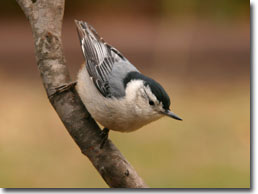White-breasted Nuthatch
Sitta carolinensis
Description & Range:
This small songbird is the most widespread species of nuthatches and is known by
its black cap (gray if female) and a chestnut lower belly. The upperparts are
pale blue-gray, and the face and underparts are white. Nuthatches have small
tails and almost no neck, making them very stocky in appearance.
White-breasted nuthatches can be found year-round in Maryland as well as
throughout much of the United States, parts of Mexico and the southern reaches
of Canada. They are a common feeder bird.
Habitat:
The White-breasted Nuthatch can be found in forests, woodlots, groves, river
woods, shade trees, and will visit birdfeeders. They are birds of matures forest
and are more often found in deciduous than coniferous forests, though you can
find them in either.
Diet:
The nuthatch is omnivorous, though it mainly eats insects such as weevil larvae,
wood-boring beetle larvae, stinkbugs, caterpillars (like gypsy moths and tent
caterpillars) and spiders. Nuthatches also eat seeds and nuts including acorns
and sunflower seeds. At birdfeeders they will eat sunflower seeds, peanuts,
suet, and peanut butter.
Reproduction:
The White-breasted Nuthatch is monogamous. Females will build their nest on
their own, lining a nest cavity with fur, bark, or dirt and then filling it will
fine grass or other soft materials. They will build their nests in natural tree
cavities in either deciduous or coniferous trees. Nuthatches will sometimes use
nest boxes. Clutch sizes range from 5-9 eggs. Once the eggs have been laid, it
takes up to two weeks until they hatch. The chicks are essentially naked and
helpless and rely on their parents until they are ready to leave the nest.
 Sounds:
Sounds:
A rapid series of low, nasal, whistled notes on one pitch: whi whi whi whi whi
whi or who who who who etc. Often, males will sing rapidly in the spring when
they are trying to attract a mate.
Behavior:
Nuthatches are very agile birds that can easily creep up and down tree trunks
using their strong legs. Often, these birds will creep upside down or sideways
to forage. Nuthatches get their name from their habit of jamming large food
pieces, like acorns, into tree crevices and then hammering them with their sharp
beak to get the seed to “hatch”. Nuthatches are also known to cache seeds for future use.
In winter, the White-breasted Nuthatch will join foraging flocks led by
chickadees or titmice. This may be because it makes food easier to find. Also
foraging in flocks allows more birds to keep an eye out for predators.
For more information on the White-breasted Nuthatch then visit the
Cornell Lab of Ornithology webpage.